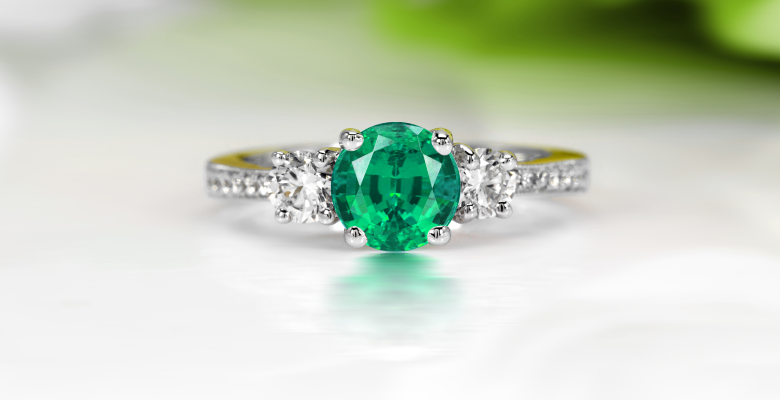How Does the Quality of Emeralds Affect Engagement Ring Selection?

When it comes to selecting an engagement ring, the quality of the gemstone plays a pivotal role, particularly for emerald engagement rings. Unlike diamonds, which are often evaluated using the well-known “Four Cs” (carat, cut, clarity, and color), emeralds have their own set of unique criteria that significantly influence their value and appearance. Understanding how these factors affect your choice can help you select an emerald engagement ring that perfectly embodies your love story.
1. Color: The Heart of the Emerald
Color is arguably the most important quality factor when selecting emerald engagement rings. The ideal emerald displays a vibrant green hue, often described as “emerald green.” Factors such as hue, tone, and saturation all contribute to the overall appearance of the stone:
– Hue: The primary color of the emerald is crucial. While emeralds can range from light green to deep green, the most sought-after stones have a rich, vivid green color.
– Tone: This refers to the lightness or darkness of the emerald’s color. A medium to dark tone is usually preferred, as it allows the stone to exhibit its vibrant color without appearing too dark or muddy.
– Saturation: This indicates the intensity of the color. Higher saturation results in a more striking appearance, which can greatly enhance the ring’s overall allure.
Emerald engagement rings with exceptional color quality often come at a higher price point, as they are rarer and more desirable. Therefore, it’s essential to find a balance between your budget and the vibrancy of the emerald.
2. Clarity: The Presence of Inclusions
Unlike diamonds, emeralds often contain inclusions or “jardin,” which are natural characteristics that can affect their clarity. These inclusions are common and do not necessarily diminish the beauty of the stone, but they do play a significant role in its quality assessment.
– Inclusions: While some inclusions can be distracting, many emerald lovers appreciate these unique features, which add character to the stone. When selecting emerald engagement rings, consider the location and size of inclusions. A stone with fewer, smaller inclusions will generally be more valuable.
– Treatment: Many emeralds are treated with oils or resins to enhance clarity. This is a standard practice in the industry, but it’s essential to ask your jeweler about any treatments, as they can affect the ring’s durability and care requirements.
Choosing an emerald with acceptable clarity for your taste and budget will enhance the overall appeal of your engagement ring.
3. Cut: Crafting the Gemstone’s Beauty
The cut of an emerald significantly influences its appearance and brilliance. Unlike diamonds, emeralds are often cut in a step-cut style, such as the emerald cut, which features rectangular facets that create a stunning visual effect.
– Shape: The traditional emerald cut is favored for its ability to showcase the stone’s color and clarity. However, other shapes, like oval, round, or pear, can also be stunning options. The chosen cut will affect the ring’s overall aesthetic, so consider what aligns best with your partner’s style.
– Proportions: The proportions of the cut, including depth and width, can affect how light interacts with the stone. An expertly cut emerald will reflect light beautifully, enhancing its visual appeal.
Emerald engagement rings with well-executed cuts will not only look more stunning but can also command higher prices. Thus, selecting the right cut is essential to achieving the desired brilliance and charm.
4. Carat Weight: Size Matters
Carat weight refers to the size of the emerald, which can impact both its price and presence. While larger stones are often more desirable, the quality of the emerald should always take precedence over size.
– Value: Larger emeralds tend to be rarer and thus more expensive, particularly if they possess exceptional color and clarity. It’s vital to consider your budget and prioritize quality over size.
– Style Preference: Depending on personal taste, some individuals prefer a larger stone, while others may find smaller, high-quality emeralds more appealing. Consider what resonates with your partner’s style when choosing carat weight.
Emerald engagement rings can vary significantly in carat weight, and finding the right balance between size and quality will ensure you select a stone that truly represents your love.
5. Durability: Understanding the Stone’s Nature
Emeralds, while beautiful, are generally softer than other gemstones, such as diamonds. This means that they require extra care to maintain their beauty over time.
– Care Considerations: Understanding the durability of the emerald can influence your choice of setting and lifestyle considerations. For example, if your partner has an active lifestyle, a more secure setting, like a bezel, might be wise to protect the stone.
– Longevity: Choosing a high-quality emerald that is less prone to chipping or damage will ensure that the engagement ring remains beautiful for years to come.
Conclusion
When selecting emerald engagement rings, the quality of the emerald is crucial to making an informed choice. Factors like color, clarity, cut, carat weight, and durability will all influence the overall appearance and value of the ring. By prioritizing quality and understanding the unique characteristics of emeralds, you can select a stunning ring that embodies your commitment and love.
Emerald engagement rings offer a beautiful and unique alternative to traditional diamond rings, making them a perfect choice for couples who appreciate their rich history and symbolism. Ultimately, the right emerald engagement ring will reflect not only the quality of the stone but also the love and commitment shared between partners.
Keep an eye for more latest news & updates on Live Buzz Insight!





